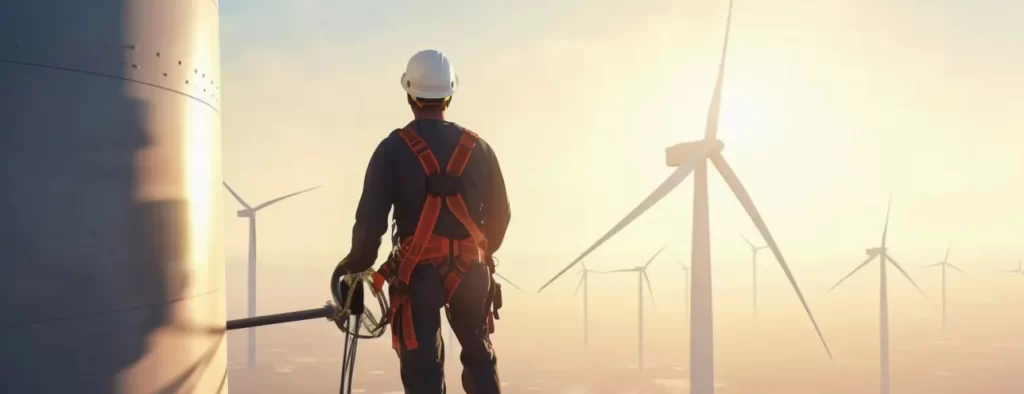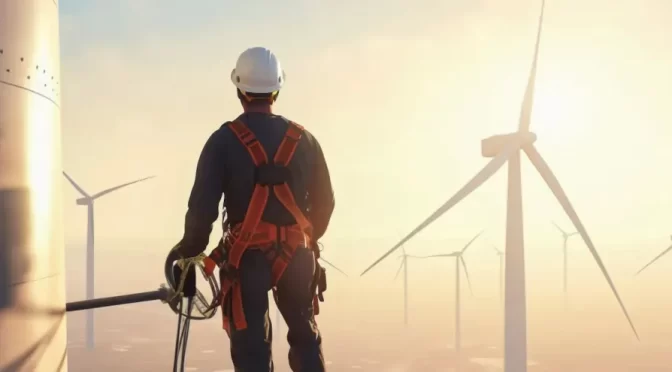DNV, the independent energy expert and assurance provider, is calling for deeper industry collaboration to develop robust offshore wind standards, ahead of the WindEurope conference in Bilbao.
Highlighting findings from the latest Energy Transition Outlook — which forecasts wind power as Europe’s primary renewable energy source by 2050, contributing to 43% of total electricity generation —, DNV is stressing the urgent need for joined up thinking to instill trust in the technologies needed to accelerate the transition towards deeply decarbonized integrated energy systems.

With ambitious net-zero objectives and sustained investments propelling large-scale green energy projects, Europe has set a precedent for renewables programmes. Against a backdrop of geopolitical complexities and industry challenges, the region has maintained its leadership in wind power, showcasing a steadfast commitment to environmental stewardship. However, the industry faces a critical juncture, as it grapples with the necessity of investing for significant growth while concurrently driving down the total costs of wind energy (LCOE). It is a challenge that is particularly acute in Europe, where the heightened market susceptibility to crises underscores the urgency for clarity in guiding the industry forward.
Standardization of offshore wind farm components and across the value chain is crucial in overcoming this challenge. DNV believes embracing international standards will play a pivotal role in realizing the full potential of wind energy, ensuring its sustainability and competitiveness globally by enabling the industrialization and scaling of supply chains.
“For four decades, DNV has been a pioneer and pivotal player in the wind industry, providing standards and certification to ensure quality, reliability, and affordability of technologies. We have acted as the primary type certifier for top wind equipment manufacturers, certifying over 70% of all global offshore wind projects,” says Ditlev Engel, CEO, Energy Systems at DNV.
“Our approach now goes beyond specific projects, offering trusted integrated solutions for scalable technology growth. Moreover, our constant involvement with all the stakeholders in the energy transition has enabled us to witness the evolution of our energy landscape firsthand. Concerns once considered peripheral, such as cyber-resilience, environmental impact, lifetime extension and decommissioning, are now central to planning and financial decisions for wind projects. As an independent expert, DNV supports sustainable growth at every stage, keeping in mind that our mission transcends technology, encompassing the well-being of the environment and communities. Our focus is first and foremost on securing and advancing the transition to reliable, deeply decarbonized integrated energy systems that scales fast and are cost competitive.”
DNV currently leads over a dozen collaborative initiatives to deliver trusted solutions to the entire wind energy sector. These encompass projects to:
- Upgrade marine operations safety and reliability standards;
- Address wind turbine end-of-life challenges;
- Protect critical assets through cyber-resilience measures;
- Alleviate cyclone and earthquake challenges for wind farms (ACE1 and ACE2);
- Implement wind turbine blade damage detection using artificial intelligence;
- Define guidelines for concrete floaters for floating offshore wind (ConcreteFLOW);
- Ensure dynamic stability for floating wind turbines;
- Provide safety and reliability guidelines for the design of floating offshore wind substations;
- Optimize mooring and dynamic inter-array cable systems;
- Promote pragmatic approaches to ground investigation;
- Analyze turbulence using LIDAR measures;
- Standardize resin uptake testing methods for the characterization of sandwich foam core materials;
- Explore early-age cycling effects on grouted connections;
- Develop certification standards for the installation aid equipment for fixed offshore wind farms;
- Provide services to prevent the erosion of the leading edge of fan rotor blades;
- Tackle environmental concerns in offshore wind planning, including biodiversity preservation.
These Joint Industry Projects and other initiatives are designed to foster innovation, safety, and sustainability across all aspects of the wind energy industry, contributing to a cleaner, more resilient energy landscape.
“We are very technology-optimistic: collaboration and knowledge-sharing drive our strategy, particularly in offshore wind projects, where we have found that joint industry efforts are best at producing robust standards to accelerate technology adoption – which, in turn, enhance energy security, and maintain Europe’s leadership in wind energy innovation,” Engel added.
At WindEurope Bilbao 2024, DNV invites industry stakeholders, policymakers, and visionaries to join their experts in the wind sector, including technology certification, plant control and monitoring (Scada, EMS, etc.), cyber-resilience, digitalization, repowering, and decommissioning – to explore innovations for the offshore industry and discuss case studies, best practices, challenges, and opportunities.
DNV’s Current Initiatives to Scale Up Offshore Wind:
- Advancing Standards for Offshore Substations and Dynamic Cables
In a joint industry project (JIP) involving 38 participating companies, DNV is leading the effort to align industry best-practices and close gaps in available substation standards, enabling scaling of floating offshore wind with an acceptable level of commercial, technical, health, safety, and environmental risks [link].
- Upgrading Marine Operations Safety and Reliability Standards
DNV has unveiled a substantial revision to the ‘go-to standard,’ DNV-ST-N001, setting a new benchmark for the design and planning of marine operations in offshore wind, subsea cables, and oil and gas assets. This major update, the first in five years, reflects DNV’s dedication to safety and reliability, aligning with the evolving nature of the offshore industry during the global energy transition [link].
- Addressing End-of-Life Challenges
ReWind, DNV’s innovative digital platform for wind farm decommissioning, has demonstrated impressive results in managing wind farm end-of-life and blade recycling processes. This platform automates planning, offering cost-effective and eco-friendly solutions. The pilot, with participation from major industry players like Ørsted, SSE, and Energia, collectively saved an estimated 1,985 workdays and €680,000 compared to traditional approaches. The service meets industry demands for credible decommissioning plans, essential in wind auction bidding processes [link].
- Redefining Concrete Floaters
ConcreteFLOW, a newly-launched JIP by DNV, is set to redefine global standards for the production of concrete floaters. With 14 key partners committed to the project, DNV aims to optimize technology development and prepare for the scale and industrialization of concrete substructures for floating offshore wind. The project focuses on driving innovation, reducing costs, and ensuring environmental friendliness in concrete floaters, particularly for larger turbine sizes [link].
- Optimizing Mooring and Dynamic Inter-Array Cable Systems
DNV’s Floating Wind Reliability JIP addresses the critical components of mooring and dynamic inter-array cable systems. The project provides valuable insights on load and capacity, offering recommendations that will form the basis for tomorrow’s design requirements [link].
- Promoting Pragmatic Approaches to Ground Investigation
To facilitate the rapid expansion of anchors in floating wind projects, DNV has initiated a JIP on site investigation and ground modeling to provide clear guidance on site conditions assessment certification and enable projects to move away from anchor location-specific geotechnical site investigation. This will ensure time and cost savings while maintaining reliable anchor design and de-risking installation processes [link].
- Protecting critical assets
DNV’s research reveals mounting concerns among power and renewables professionals, with 64% expressing worry about increased vulnerability to cyberattacks on their operational technology (OT) networks. DNV addresses these concerns by targeting vulnerabilities in the supply chain, adopting a “security by design” approach, and ensuring compliance with stringent cyber security regulations, all aimed at enhancing the cyber resilience of wind farms.
- Implementing wind turbine blade damage detection using artificial intelligence (Blade-AI)
DNV is launching a JIP to define an approach for the third-party validation of the techniques used for the automatic processing of blade inspection data. Additionally, the project will outline the technical requirements for the acquisition and handling of inspection data, develop a system for the classification of findings based on the detecting and recognition capabilities of the algorithms, and define a reporting format related to inspection findings [link].
- Tackling Environmental Concerns in Offshore Wind Planning
DNV takes an active role in the development of environment management plans and frameworks, aligning them with IUCN guidelines and the Task Force on Nature-related Financial Disclosure (TNFD). The company conducts baseline studies, monitors impacts, and devises solutions for the collection, storage, use, and sharing of environmental data, fostering informed decision-making and transparency. The recent acquisition of Enviroguide Consulting further bolsters DNV’s capabilities, encompassing expertise in biodiversity, contaminated land, waste management & licensing, ESG, Infrastructure Planning, and Environmental Impact Assessment services [link].
- Analyzing turbulence using LIDAR measures
The purpose of the JIP is to develop recommendations and establish acceptance criteria to use Lidar TI measurements for different applications, such as site assessment, load validation and power curve measurement [link].
- Standardizing sandwich core test methods
This JIP aims to define and standardize resin uptake testing methods for the characterization of sandwich foam core materials to generate comparability and improve data validity and reliability, thus increasing the efficiency of product qualifications and the compatibility and interoperability between products [link].
- Exploring early-age cycling effects on grouted connections
The topic of Environmental Assisted Cracking (EAC) remains relatively immature and undeveloped. Few dedicated tests have been conducted to fully grasp its phenomena, and the database for evaluating its effects is limited, often based on small-scale tests unsuitable for the increasing size of offshore wind turbine support structures. The goal of this JIP is to provide enhanced guidance in DNV-ST-0126 on how to manage the effects of EAC for grouted connections, ensuring greater clarity and efficiency in asset integrity management [link].
- Developing certification standards for fixed-bottom construction equipment
DNV is leading partners in a JIP to provide a common framework and decision tools for the specification; design; manufacture; procurement and approval of any equipment intended for the installation and decommissioning of fixed wind turbines [link].
- Providing services for rotor blade leading-edge erosion prevention
DNV has led two Joint Industry Projects to develop Recommended Practices [Link 1] [Link 2]
- Ensuring dynamic stability for floating wind turbines
DNV plan on enhancing verification criteria for floating wind turbine stability, employing time domain coupled analysis, and establishing safety margins for dynamic stability against capsizing (leveraging maritime experience to develop dynamic criteria) for the development of optimized structures without compromising safety.
- Providing safety and reliability guidelines for the design of floating offshore wind substations
The first outcomes of this DNV-led JIP include confirming the feasibility of floating offshore substations (FOSS) and export cables, pinpointing technology gaps requiring attention, and assessing the maturity of AC solutions versus DC. Additionally, a feasibility analysis was conducted for various floater types and dynamic export cable concepts. DNV intends to integrate these findings into the next updates of DNV-ST-0145 for floating substations and DNV-ST-0359 for dynamic cables, slated for release in 2024, to enhance the robustness of the design process for optimized integrated floating substations [link].
- Alleviating cyclone and earthquake challenges for wind farms (ACE1 and ACE2)
DNV has led two JIPs to develop guidance and standards for seismic design [link].


